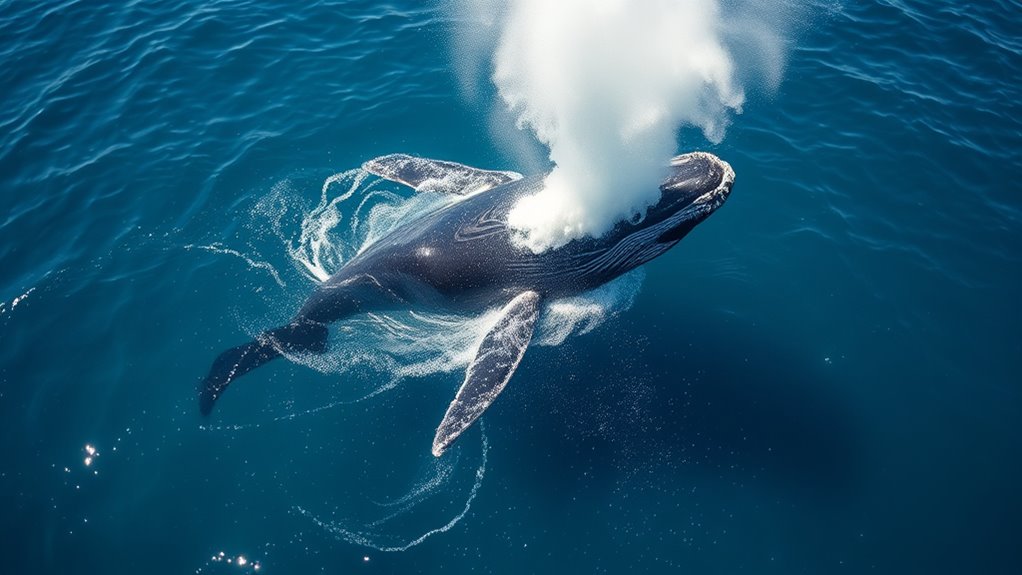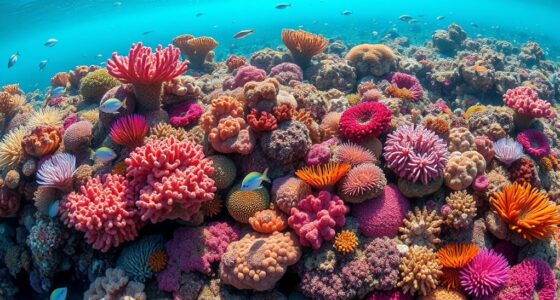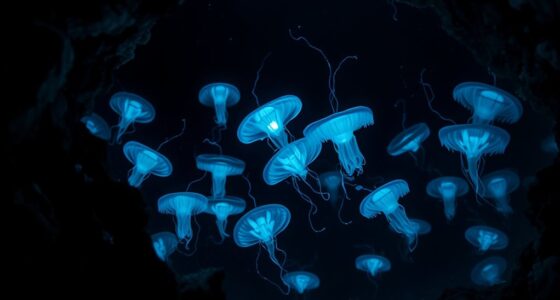Whales help fight climate change by fertilizing the oceans with nutrients like nitrogen and iron found in their excrement. As they surface and defecate, these nutrients stimulate the growth of phytoplankton, tiny plants that absorb carbon dioxide during photosynthesis. More phytoplankton means more carbon gets pulled from the atmosphere, helping to slow climate change. If you’re curious about how this natural process works and what it means for our planet, there’s more to explore.
Key Takeaways
- Whales fertilize oceans with nutrients like nitrogen and iron through their excrement.
- Nutrients from whales promote phytoplankton growth, the foundation of the marine food web.
- Increased phytoplankton absorb more carbon dioxide during photosynthesis, reducing atmospheric CO2.
- Whale-driven nutrient cycling enhances ocean carbon sequestration, helping mitigate climate change.
- Protecting whale populations supports natural ocean fertilization and the planet’s climate regulation.

Climate change poses a significant threat to whale populations, impacting their habitats, migration patterns, and food sources. As ocean temperatures rise and ice melts, whales face challenges that threaten their survival. But you might not realize that whales also play an essential role in combating climate change itself. By participating in marine nutrient cycling, whales help fertilize the ocean, supporting the productivity of marine ecosystems. This process is fundamental for maintaining healthy ocean environments and promoting whale population recovery.
Whales help fertilize oceans, supporting ecosystems and fighting climate change through nutrient cycling.
When whales feed and migrate, they influence the distribution of nutrients across vast ocean areas. Their excrement contains necessary nutrients like nitrogen and iron, which are often limited in the open ocean. As whales surface and defecate at different depths, they effectively transport nutrients from the deep waters to the surface. This natural fertilization encourages the growth of phytoplankton, microscopic plants that form the foundation of the ocean’s food web. Phytoplankton absorb carbon dioxide during photosynthesis, acting as a carbon sink that helps mitigate climate change. In this way, whales contribute to marine nutrient cycling that supports the entire marine food chain.
The benefits of this process extend beyond just supporting phytoplankton growth. As phytoplankton populations increase, they draw down more carbon from the atmosphere, helping slow global warming. This creates a positive feedback loop: healthier whale populations lead to better nutrient distribution, which boosts phytoplankton and enhances carbon sequestration. Consequently, protecting whales isn’t only about conserving species; it’s about maintaining these natural processes that help regulate Earth’s climate.
However, climate change threatens to disrupt this delicate balance. Warmer waters and changing ocean currents can alter whale migration routes and breeding grounds, reducing their ability to perform these essential ecological roles. If whale populations decline, the natural fertilization process weakens, leading to less phytoplankton growth and diminished carbon absorption. This underscores the importance of supporting whale conservation efforts, not just for the animals themselves but for the health of the entire planet.
In essence, whales serve as oceanic gardeners, fostering marine nutrient cycling that sustains diverse ecosystems. Their role is integral to climate regulation. By ensuring the recovery and protection of whale populations, you help maintain these natural fertilization processes. This interconnected system demonstrates how whale conservation directly contributes to fighting climate change, showing that protecting these magnificent creatures benefits Earth in profound ways.
Frequently Asked Questions
How Do Whale Populations Impact Global Carbon Levels Long-Term?
You might wonder how whale populations influence long-term carbon levels. When whales release feces, they enrich the ocean with nutrients, promoting the growth of phytoplankton. These tiny plants absorb carbon dioxide during photosynthesis, helping with carbon sequestration. By supporting phytoplankton, whales play an essential role in reducing atmospheric carbon, making their populations indispensable for maintaining long-term climate balance and fighting climate change.
Can Whale Conservation Efforts Directly Reduce Climate Change Effects?
You might wonder if conserving whales can directly lessen climate change effects. Scientific theories suggest whale migration and acoustic communication help maintain healthy marine ecosystems, which in turn support carbon absorption. By protecting whales, you’re ensuring their natural behaviors continue, helping ocean ecosystems thrive. This activity boosts ocean fertilization and carbon sequestration, making whale conservation a crucial, proactive step in combating climate change’s impacts.
Are Certain Whale Species More Effective at Fertilizing Oceans?
You might wonder if some whale species are better at fertilizing oceans than others. Species variation and feeding habits play a big role in this. For example, baleen whales like blue and humpback whales consume large amounts of plankton and krill, which helps transfer essential nutrients to the surface. This makes certain species more effective at fertilizing oceans and supporting carbon sequestration, ultimately aiding in climate change mitigation.
How Do Human Activities Threaten Whales’ Role in Climate Regulation?
They say “a chain is only as strong as its weakest link,” and human activities threaten whales’ essential role in climate regulation. Marine noise and pollution impacts disrupt whale communication, navigation, and feeding behaviors. These disturbances weaken whale populations, reducing their ability to fertilize oceans with nutrients. When we harm whales, we compromise their natural climate-stabilizing functions, highlighting the urgent need to reduce human impacts to protect our planet’s health.
What Are the Potential Consequences of Declining Whale Populations?
If whale populations decline, you’ll notice serious ecosystem imbalances. The reduction in whales means less fertilization of the oceans, which affects phytoplankton growth. This decline can disrupt the food chain, harming fish and other marine life. You might see changes in climate regulation because fewer whales mean less carbon absorption. Overall, a declining whale population threatens the health of marine ecosystems and the stability of our planet’s climate.
Conclusion
By understanding how whales boost ocean health, you realize they’re like gentle giants planting nature’s own fertilizer, helping our planet breathe easier. Their crucial role in fertilizing the oceans fuels tiny marine life that absorb carbon, acting as Earth’s natural air filters. Protecting whales isn’t just about saving majestic creatures — it’s about safeguarding our future. When you support their conservation, you’re helping keep the Earth’s lungs clear, ensuring a healthier planet for generations to come.









